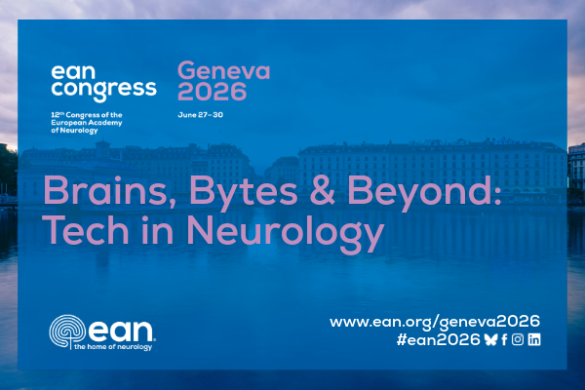
by Elena Moro
For November 2018, we have selected: Oh KW, Noh MY, Kwon NS, et al. Repeated intrathecal stem cells for amyotrophic lateral sclerosis. Ann Neurol 2018;84:361-373.
Stem cell research is a hot topic in motor neuron disease/amyotrophic lateral sclerosis (MND/ALS) both for clinicians and patients. Whilst recognized as an important area of promise for developing future therapeutics in neurodegenerative disease, it has been much hyped in the media, and dissecting the scientific research on the subject from the many unproven approaches advertised to patients by commercially motivated companies can be challenging. Our paper of the month is a randomized controlled trial that makes a genuine contribution to the literature on stem cell approaches in ALS.
The Korean authors of this paper performed a phase 2 randomized controlled trial of autologous mesenchymal stem cells derived from bone marrow and delivered intrathecally to 33 patients, compared to 31 disease controls, treated with riluzole alone. Patients were recruited from a single centre in Seoul. Inclusion criteria were age 25-75 years, clinically probable or definite ALS by revised El Escorial criteria, an ALSFRS-R (patient-reported disability rating) score of 31-46, stable riluzole therapy at standard doses for at least 3 months, and disease duration of less than 5 years from symptom onset. Exclusions were involvement in other trials within 12 months, forced vital capacity of <40%, any comorbidity that might confound outcomes, tracheostomy or non-invasive ventilation, haemorrhagic tendency or any drug that could affect bone marrow.
The trial design included a 3-month lead-in period. Patients were genotyped. Bone marrow was extracted from patients randomly assigned to stem cell treatment after 2 and 3 months lead-in, the last extraction 2 days before day zero when the first treatment was given. A second treatment was given one month later, allowing 28 days between each bone marrow extraction and subsequent treatment, to give time to expand the stem cells for intrathecal delivery. One day before each delivery, a lumbar puncture was performed and 20-30mls of cerebrospinal fluid was extracted to analyze cytokine profiles and suspend the cultured stem cells. A million cells per kg body weight were delivered at each treatment. There was no sham procedure in controls, so the trial was effectively open-label. Outcomes of safety and efficacy were assessed. Patients were followed up with physical, neurological examination and ALSFRS-R at monthly intervals for 6 months and monitored at intervals for any clinical, haematological or biochemical adverse events, the latter including assessment of full blood count, renal and liver function and urinalysis. The primary efficacy outcome measure was change in ALSFRS-R between baseline and 4 months. Additional clinical assessments including Appel clinical status scores, forced vital capacity and the SF-36 quality-of-life measure were secondary outcomes. Changes in cytokine profiles were assessed from CSF derived just before each of the two treatments i.e. just before first treatment and after a month of therapy. Survival was censored approximately 5 years after the last patient follow-up visit. T-tests were used to compare differences between groups to assess primary and secondary outcomes.
There were no systematic clinical or demographic differences between treated and untreated groups at baseline. No patient had an identified gene mutation. Fifty-six of the 64 patients completed 6 months follow-up. There were 20/33 adverse events in the stem cell group and 22/31 in controls. The most common events in the stem cell group were a flu-like illness, back and musculoskeletal pain. There were 3 serious adverse events in the stem cell group, including 1 death from ALS, none of which were judged treatment-related, and 6 serious adverse events in the control group (3 deaths). Mean change in ALSFRS-R was 3.0 points slower in the stem cell group than the control group at 4 months (p<0.001) and 3.4 points at 6 months (p=0.003). Change in Appel scores was also significantly reduced, but there was no difference in forced vital capacity, quality of life or survival. Following treatment, changes were demonstrated in a number of cytokines, including an increase in IL-6 and IL-10 and a decrease in TNF-alpha. Changes in the levels of monocyte chemoattractant protein (MCP-1) and transforming growth factor (TGF Beta 1) were highlighted as potential biomarkers of treatment response.
The authors concluded that the treatment was safe and that the differences observed in ALSFRS-R merit a larger, phase 3 trial. The main limitation of the study was the lack of a sham control in the context of a patient-reported primary outcome measure, meaning that the trial was prone to bias due to placebo effect. The reason given was that the relatively invasive nature of bone marrow harvest and lumbar punctures made sham control group unethical, illustrating the difficulties in studying such cell-based treatments.
“This study is a welcome addition to the scientific literature on the application of stem cell-based therapies in ALS”, said Prof Pamela Shaw, Department of Neurology, Sheffield Institute for Translational Neuroscience (SITraN) University of Sheffield, UK. “Whilst the trial has some important limitations, the study has demonstrated safety, which is important, and the efficacy data are encouraging, but must be treated with caution, because a sham control was not used. It should be emphasized to patients that this work is different from the many companies across the world offering commercial stem cell treatments of dubious origin and unproven efficacy to patients with ALS, who are understandably desperate for more effective treatments than are currently available. It is also important to note that this study did not observe a difference in survival. However, given the safety observed and the indications of benefit, further work in this area should be pursued”
“A larger phase 3 trial is now warranted,” said Prof Vincenzo Silani, Department of Neurology, IRCCS Istituto Auxologico Italiano, University of Milan Medical School, Italy. “It is a challenge for the scientific community to reconcile the development of effective trial designs to reduce bias, whilst balancing the ethics of sham control procedures in trials of stem cell therapy that require relatively invasive harvest and delivery methods. Engagement with patient groups will be important to achieve consensus on the right way to proceed to evaluate these therapies in the most objective way possible. The search for more effective treatments for ALS continues.”
The other nominees for the November 201* paper of the month are:
- Chitnis T, Arnold DL, Banwell B, et al., for the PARADIGMS Study Group. Trial of fingolimod versus interferon beta-1a in pediatric multiple sclerosis. N Engl J Med 2018;379:1017-27. In 215 patients between 10 and 17 years of age with relapsing remitting multiple sclerosis, the effects of oral fingolimod versus intramuscular interferon beta-1a were assed over a 2-year period. The adjusted annualized relapse rate was 0.12 with fingolimod and 0.67 with interferon beta-1a (absolute difference, 0.55 relapses; relative difference, 82%; P<0.001). Moreover, fingolimod had less accumulation of brain MRI lesion. However, fingolimod had higher rate of serious adverse events.
- Bassez G, Audureau E, Hogrel J-Y, et al. Improved mobility with metformin in patients with myotonic dystrophy type 1; a randomized controlled trial. Brain 2018;141:2855-2865. In this randomized, placebo-controlled trial, oral metformin or placebo were administered TID up to 3 g/day in 40 patients with myotonic dystrophy type 1. Twenty-three patients completed the study at 1 year. The nine treated patients showed significantly better 6-minute walk test compared to the 14 patients with placebo. Adverse events were more common in the treated group, mainly gastrointestinal dysfunction.
- Kasner SE, Swaminathan B, Lavados P, et al., on behalf of the NAVIGATE ESUS Investigators. Rivaroxaban or aspirin for patent foramen ovale and embolic stroke of undetermined source: a prespecified subgroup analysis from the NAVIGATE ESUS trial. Lancet Neurol, September 2018. org/10.1016/ S1474-4422(18)30319-3. In the NAVIGATE ESUS trial, efficacy and safety of rivaroxaban (an oral factor Xa inhibitor) versus aspirin were assessed for secondary stroke prevention in patients with embolic stroke of undetermined source (ESUS). In this paper, the authors made a prespecified subgroup analysis considering the presence or absence of patent foramen ovale and assessing time to recurrent ischemic stroke between groups. Patients with PFO assigned to receive aspirin had a recurrent ischemic stroke rate of 4·8 events per 100 person-years compared with 2·6 events per 100 person-years in those treated with rivaroxaban The risks of major bleeding with rivaroxaban versus aspirin were similar in patients with PFO detected and in those without PFO detected.











